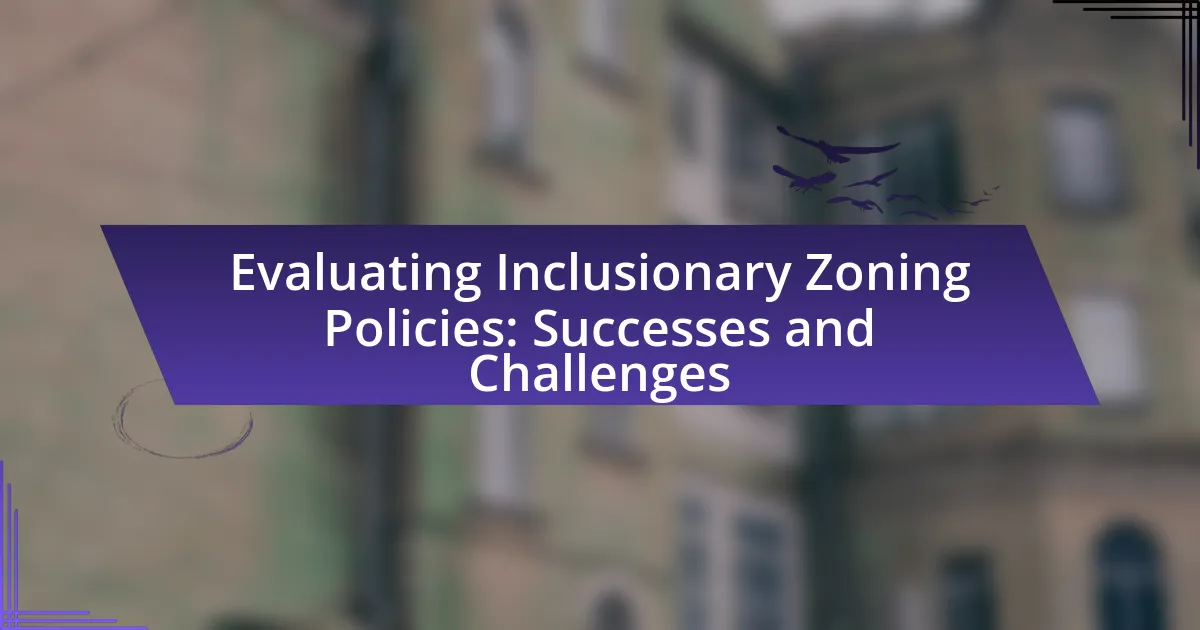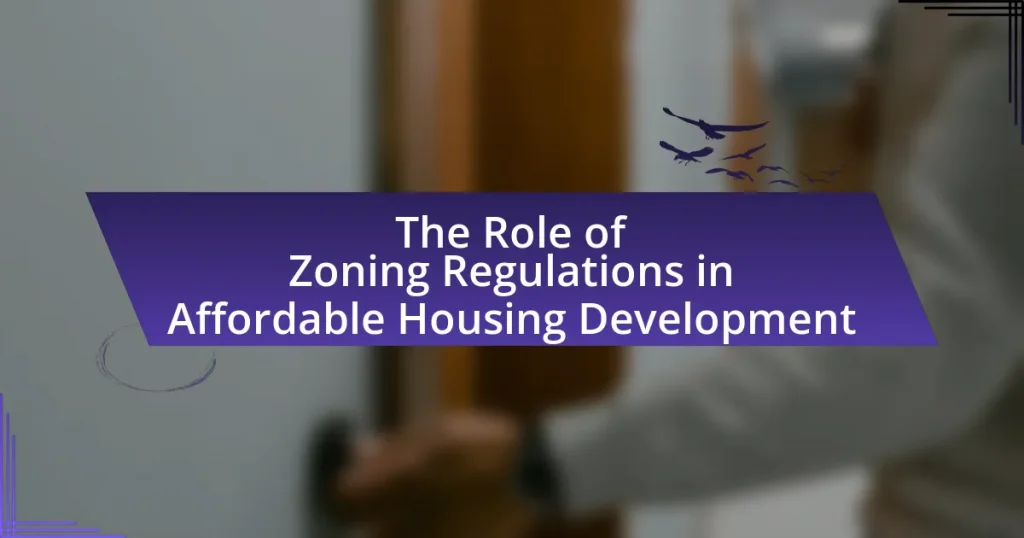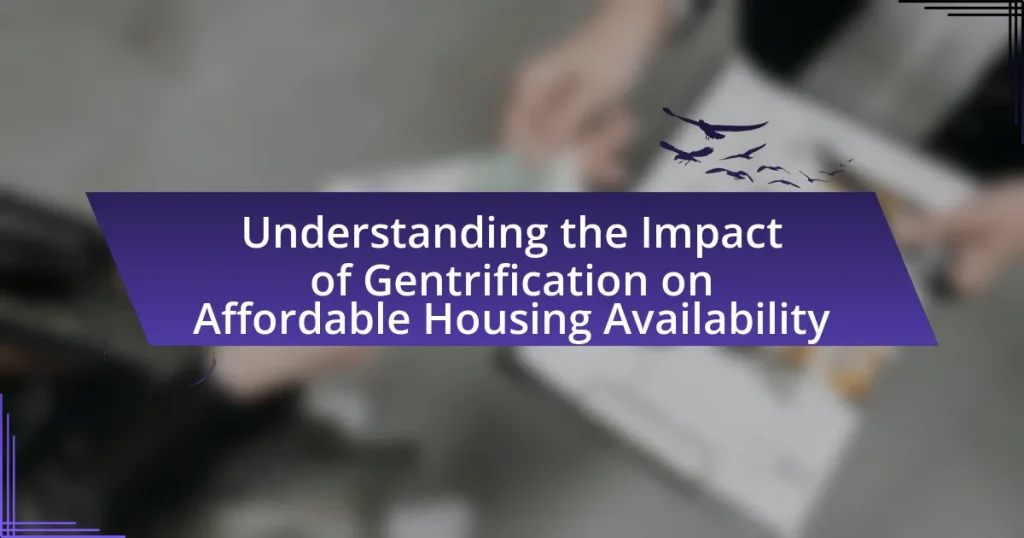Inclusionary zoning policies are regulations that mandate a percentage of new housing developments to be affordable for low- and moderate-income residents, aiming to foster mixed-income communities and address housing shortages. This article evaluates the effectiveness of these policies, highlighting their key components, successes, and challenges faced in urban planning. It discusses how inclusionary zoning interacts with local housing markets, its impact on community development, and the social equity benefits it promotes. Additionally, the article examines criticisms, unintended consequences, and strategies for enhancing policy effectiveness, providing a comprehensive overview of the role of inclusionary zoning in increasing affordable housing availability.
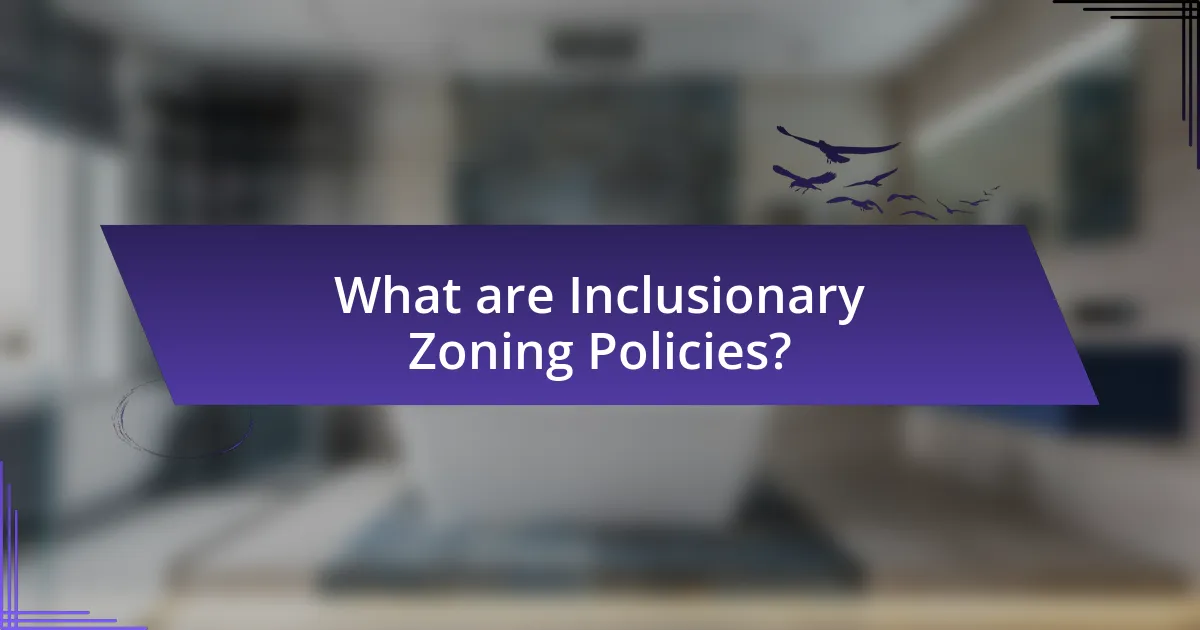
What are Inclusionary Zoning Policies?
Inclusionary zoning policies are regulations that require a certain percentage of new housing developments to be affordable for low- and moderate-income residents. These policies aim to promote mixed-income communities and increase the availability of affordable housing in areas experiencing growth or gentrification. Evidence from various cities indicates that inclusionary zoning can lead to a significant increase in affordable housing units; for instance, San Francisco’s inclusionary zoning policy has produced thousands of affordable units since its implementation.
How do Inclusionary Zoning Policies function in urban planning?
Inclusionary zoning policies function in urban planning by mandating or incentivizing developers to include a certain percentage of affordable housing units in new residential developments. These policies aim to increase the availability of affordable housing in areas experiencing growth and rising property values, thereby promoting socioeconomic diversity within communities. For instance, cities like San Francisco and New York have implemented inclusionary zoning, requiring developers to allocate 10-25% of units as affordable, which has resulted in thousands of affordable units being created. This approach addresses housing shortages and mitigates displacement of low-income residents, demonstrating its effectiveness in urban planning.
What are the key components of Inclusionary Zoning Policies?
Inclusionary Zoning Policies primarily consist of requirements for developers to include a certain percentage of affordable housing units in new residential developments. These policies aim to increase the availability of affordable housing in areas experiencing growth and gentrification. Key components include the percentage of units designated as affordable, income eligibility criteria for residents, the duration of affordability (often set for a specific number of years), and incentives or concessions for developers, such as density bonuses or reduced parking requirements. These components are designed to ensure that a diverse range of income levels can access housing in desirable neighborhoods, thereby promoting social equity and community integration.
How do these components interact with local housing markets?
Inclusionary zoning policies interact with local housing markets by mandating a percentage of new developments to be affordable for low- to moderate-income households. This requirement influences the supply of affordable housing, which can help mitigate housing shortages in high-demand areas. For instance, a study by the Urban Institute found that cities implementing inclusionary zoning saw a 10-20% increase in affordable housing units compared to those without such policies. Additionally, these policies can affect market dynamics by potentially increasing overall housing prices due to reduced supply of market-rate units, as developers may pass on costs associated with compliance to buyers.
What objectives do Inclusionary Zoning Policies aim to achieve?
Inclusionary Zoning Policies aim to achieve the objective of increasing the availability of affordable housing within a community. These policies require developers to include a certain percentage of affordable units in new residential developments, thereby promoting socioeconomic diversity and preventing displacement of low-income residents. Evidence from various cities shows that such policies can lead to a measurable increase in affordable housing stock; for instance, San Francisco’s Inclusionary Housing Program has resulted in thousands of affordable units since its inception.
How do these policies promote affordable housing?
Inclusionary zoning policies promote affordable housing by requiring developers to allocate a percentage of new residential units for low- and moderate-income households. This approach directly increases the supply of affordable units within market-rate developments, addressing housing shortages. For example, cities like San Francisco and New York have implemented such policies, resulting in thousands of affordable units being created alongside market-rate housing. Studies indicate that these policies can lead to a more equitable distribution of housing resources, thereby enhancing community diversity and stability.
What role do Inclusionary Zoning Policies play in community development?
Inclusionary Zoning Policies play a crucial role in community development by promoting affordable housing within new residential developments. These policies require developers to allocate a percentage of units for low- to moderate-income households, thereby increasing housing accessibility and diversity in communities. For example, cities like San Francisco and New York have implemented such policies, resulting in thousands of affordable units being created, which helps mitigate housing shortages and supports socio-economic integration. Studies indicate that areas with Inclusionary Zoning see improved community cohesion and reduced displacement of low-income residents, demonstrating their effectiveness in fostering inclusive growth.
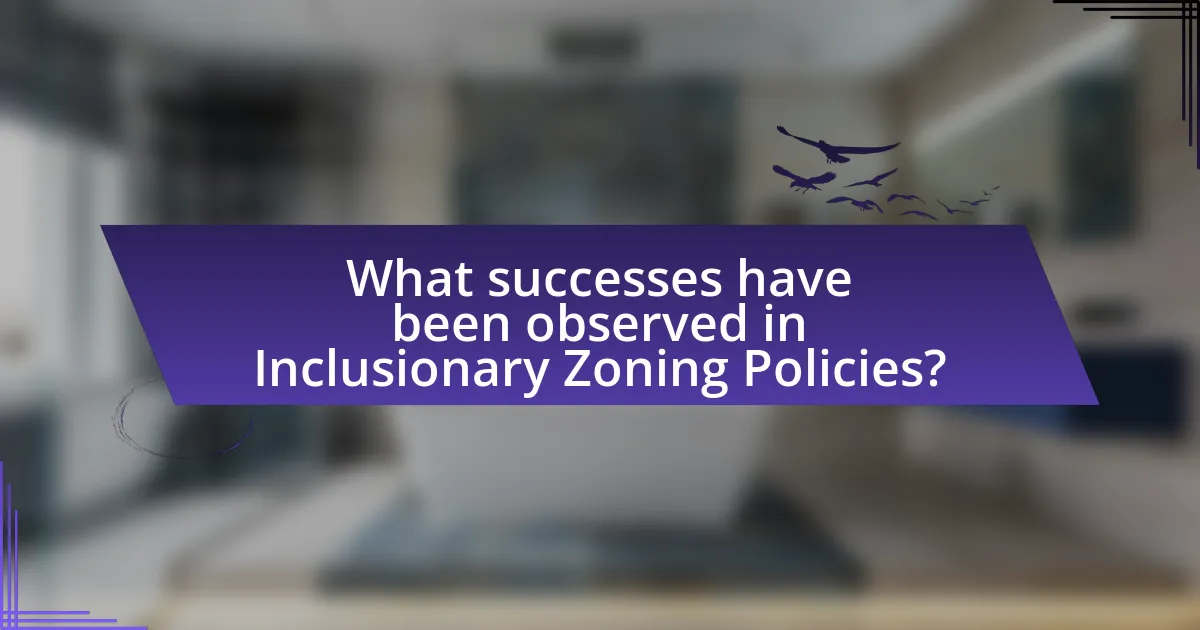
What successes have been observed in Inclusionary Zoning Policies?
Inclusionary Zoning Policies have successfully increased the availability of affordable housing in various urban areas. For instance, cities like San Francisco and New York have implemented these policies, resulting in thousands of affordable units being created. In San Francisco, the inclusionary zoning policy has led to the construction of over 1,500 affordable units since its inception in 2006. Similarly, New York City’s Mandatory Inclusionary Housing program has produced more than 2,000 affordable units in neighborhoods undergoing rezoning. These successes demonstrate the effectiveness of inclusionary zoning in addressing housing shortages and promoting socio-economic diversity within communities.
How have Inclusionary Zoning Policies increased affordable housing availability?
Inclusionary Zoning Policies have increased affordable housing availability by mandating that a percentage of new residential developments be set aside for low- and moderate-income households. This requirement directly contributes to the creation of affordable units within market-rate developments, thereby expanding the overall housing stock accessible to lower-income residents. For instance, a study by the Urban Institute found that cities implementing these policies saw a significant increase in affordable housing units, with some areas reporting up to 20% of new units designated as affordable. This approach not only addresses housing shortages but also promotes socioeconomic diversity within communities.
What case studies illustrate successful implementation?
Case studies that illustrate successful implementation of inclusionary zoning policies include the San Francisco Inclusionary Housing Program and the Montgomery County Moderately Priced Dwelling Unit Program. The San Francisco program, established in 2002, mandates that developers set aside a percentage of new housing units for low- and moderate-income residents, resulting in over 1,500 affordable units created by 2020. Similarly, Montgomery County’s program, initiated in 1974, has produced more than 14,000 affordable units, demonstrating a long-term commitment to affordable housing through a requirement that developers include affordable units in their projects. These examples provide concrete evidence of effective inclusionary zoning policies leading to increased affordable housing availability.
How do these successes impact local economies?
Successes in inclusionary zoning policies positively impact local economies by increasing affordable housing availability, which in turn stimulates economic growth. When more affordable housing options are available, lower-income families can reside in areas with better job opportunities, leading to increased workforce participation and productivity. A study by the Urban Institute found that inclusionary zoning can lead to a 10% increase in local employment rates as diverse populations move into previously inaccessible neighborhoods. Additionally, increased housing stability contributes to higher consumer spending in local businesses, further boosting the economy.
What positive social outcomes have resulted from Inclusionary Zoning Policies?
Inclusionary Zoning Policies have resulted in increased affordable housing availability, fostering diverse communities. These policies require developers to include a percentage of affordable units in new housing projects, which directly addresses housing shortages for low- and moderate-income families. For instance, a study by the Urban Institute found that cities implementing such policies saw a significant rise in the number of affordable units, contributing to reduced economic segregation and improved access to essential services for lower-income residents. Additionally, these policies promote social integration, as they encourage a mix of income levels within neighborhoods, enhancing community cohesion and stability.
How do these policies contribute to social equity?
Inclusionary zoning policies contribute to social equity by mandating a percentage of affordable housing units in new developments, thereby increasing access to housing for low- and moderate-income families. These policies help to reduce economic segregation by integrating diverse income groups within communities, which can lead to improved access to essential services such as education and healthcare. For instance, a study by the Urban Institute found that cities implementing inclusionary zoning saw a 20% increase in affordable housing availability, directly benefiting marginalized populations.
What community benefits have been documented?
Community benefits documented in the context of inclusionary zoning policies include increased affordable housing availability, enhanced neighborhood diversity, and improved local economic conditions. Studies have shown that inclusionary zoning can lead to a significant increase in the stock of affordable units; for instance, a report by the Urban Institute found that cities implementing such policies saw a 15-20% rise in affordable housing options. Additionally, these policies contribute to social equity by promoting mixed-income communities, which can reduce segregation and foster social cohesion. Economic benefits are also evident, as diverse neighborhoods often experience higher local business activity and increased property values, further supporting community development.
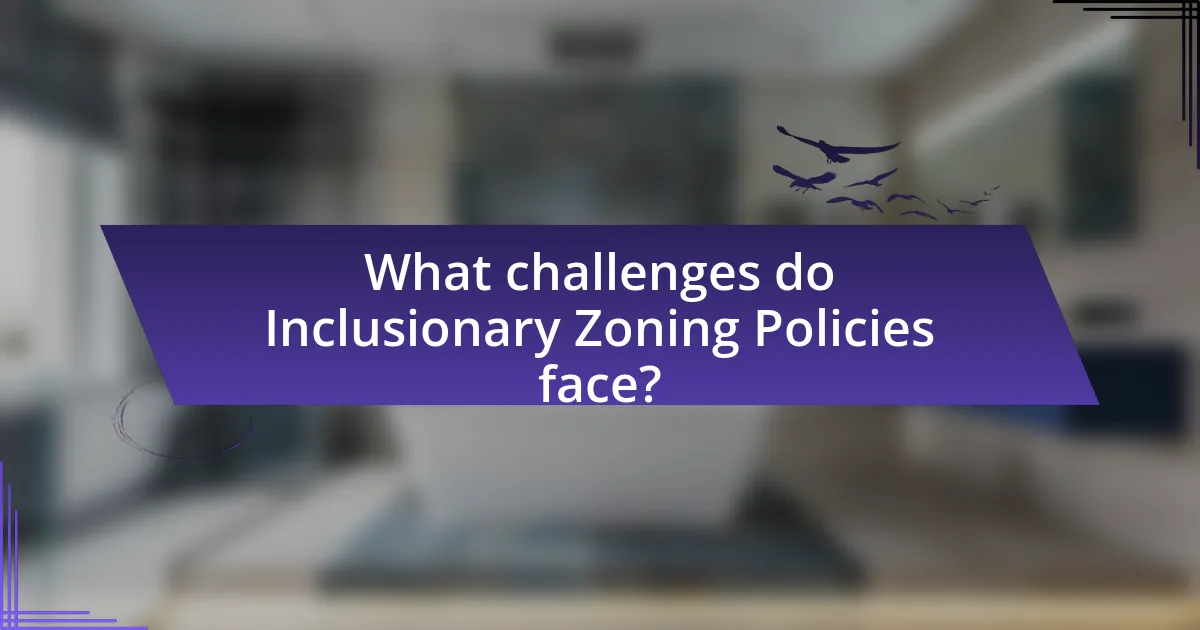
What challenges do Inclusionary Zoning Policies face?
Inclusionary zoning policies face significant challenges, including opposition from developers, legal constraints, and market dynamics. Developers often argue that these policies reduce profitability, leading to resistance against their implementation. Legal constraints can arise from state laws that limit local governments’ ability to enforce such policies, creating a barrier to effective zoning. Additionally, market dynamics, such as housing demand and supply fluctuations, can undermine the effectiveness of inclusionary zoning by making it difficult to maintain affordable housing levels in high-demand areas. These challenges collectively hinder the successful implementation and sustainability of inclusionary zoning initiatives.
What are the common criticisms of Inclusionary Zoning Policies?
Common criticisms of Inclusionary Zoning Policies include their potential to reduce overall housing supply, create economic burdens on developers, and lead to the concentration of low-income residents in specific areas. Critics argue that by mandating affordable units, these policies can discourage new construction, as developers may find it financially unviable to build in certain markets. For instance, a study by the Urban Institute found that in some cities, inclusionary zoning has led to a decrease in housing production by as much as 20%. Additionally, opponents claim that these policies can inadvertently perpetuate socioeconomic segregation, as affordable units are often located in less desirable neighborhoods, limiting access to resources and opportunities for low-income families.
How do these criticisms affect public perception?
Criticisms of inclusionary zoning policies significantly shape public perception by fostering skepticism about their effectiveness and fairness. When stakeholders highlight issues such as insufficient affordable housing units or the potential for gentrification, public trust in these policies diminishes. For instance, a study by the Urban Institute found that negative perceptions can lead to community resistance against new developments, ultimately hindering policy implementation. This skepticism can result in decreased support for future housing initiatives, as residents may question the government’s commitment to addressing housing needs.
What unintended consequences have been reported?
Unintended consequences reported from inclusionary zoning policies include increased housing prices in non-targeted areas and reduced overall housing supply. Studies indicate that when developers are required to include affordable units, they may raise prices on market-rate units to compensate, leading to higher costs in surrounding neighborhoods. Additionally, some developers may opt to build fewer units overall or shift to luxury developments to avoid the inclusionary requirements, which can exacerbate housing shortages. For instance, a report by the Urban Institute found that in cities with stringent inclusionary zoning, the overall housing stock decreased by 10% as developers adjusted their strategies.
How do economic factors influence the effectiveness of Inclusionary Zoning Policies?
Economic factors significantly influence the effectiveness of Inclusionary Zoning Policies by determining the demand for housing and the financial feasibility of development projects. When the economy is strong, higher demand for housing can lead to increased construction activity, making it easier for developers to incorporate affordable units into their projects. Conversely, during economic downturns, reduced demand can result in fewer new developments, limiting the implementation of these policies. For instance, a study by the Urban Institute found that in cities with robust economies, Inclusionary Zoning can lead to a 10-20% increase in affordable housing units, while in weaker economies, the impact is often negligible due to financial constraints on developers. Thus, the economic climate directly affects both the willingness of developers to comply with Inclusionary Zoning requirements and the overall success of these policies in increasing affordable housing stock.
What role does market demand play in policy success?
Market demand is crucial for the success of inclusionary zoning policies as it directly influences the feasibility and effectiveness of such policies. When market demand for housing is high, inclusionary zoning can lead to increased affordable housing units, as developers are incentivized to comply with regulations to meet the demand. Conversely, low market demand can result in developers being less willing to engage in projects that include affordable units, undermining the policy’s objectives. For instance, a study by the Urban Institute found that in areas with strong housing demand, inclusionary zoning policies successfully increased the supply of affordable housing, while in weaker markets, these policies often failed to produce significant results.
How do funding and resources impact implementation?
Funding and resources significantly impact the implementation of inclusionary zoning policies by determining the scale and effectiveness of the initiatives. Adequate funding allows for comprehensive planning, community engagement, and the provision of necessary infrastructure, which are essential for successful policy execution. For instance, a study by the Urban Institute found that cities with robust financial backing for affordable housing initiatives were more likely to meet their housing goals, demonstrating a direct correlation between resource allocation and successful implementation outcomes. Conversely, insufficient funding can lead to incomplete projects, reduced community support, and ultimately, policy failure, as seen in various case studies where budget constraints hindered the development of affordable housing units.
What legal and political challenges do Inclusionary Zoning Policies encounter?
Inclusionary Zoning Policies encounter significant legal and political challenges, primarily related to property rights and local government authority. Legal challenges often arise from property owners who argue that these policies constitute a form of regulatory taking, violating the Fifth Amendment, which protects against the government taking private property without just compensation. For instance, in the case of Kelo v. City of New London, the Supreme Court highlighted the complexities surrounding government regulation and property rights, illustrating the potential for legal disputes.
Politically, Inclusionary Zoning Policies face opposition from developers and local interest groups who argue that such regulations can deter investment and lead to reduced housing supply. This opposition can manifest in lobbying efforts against policy implementation, as seen in various municipalities where developers have successfully influenced local government decisions. Additionally, political challenges may stem from differing priorities among local officials, where the push for affordable housing competes with other economic development goals. These factors contribute to the contentious landscape surrounding Inclusionary Zoning Policies, making their implementation and sustainability complex.
How do local regulations affect policy enforcement?
Local regulations significantly influence policy enforcement by establishing the legal framework within which policies operate. These regulations dictate the specific requirements and procedures that must be followed, impacting how effectively policies are implemented. For instance, in the context of inclusionary zoning, local regulations can determine the percentage of affordable units required in new developments, as seen in cities like San Francisco, where local mandates have led to the creation of thousands of affordable housing units. Additionally, local enforcement mechanisms, such as zoning boards and planning commissions, play a crucial role in monitoring compliance and addressing violations, thereby directly affecting the success of policy objectives.
What political opposition is commonly faced?
Political opposition commonly faced in the context of inclusionary zoning policies includes resistance from property developers and local business interests. These stakeholders often argue that such policies can reduce profitability and discourage new housing developments. For instance, a study by the Urban Institute found that developers frequently lobby against inclusionary zoning, claiming it leads to increased construction costs and potential project cancellations. Additionally, local governments may face pushback from constituents who fear that inclusionary zoning could lead to changes in neighborhood demographics or property values.
What strategies can enhance the effectiveness of Inclusionary Zoning Policies?
To enhance the effectiveness of Inclusionary Zoning Policies, jurisdictions can implement strategies such as increasing the percentage of affordable units required in new developments, providing financial incentives for developers, and ensuring robust enforcement mechanisms. Increasing the percentage of affordable units can directly address housing shortages; for example, cities like San Francisco have mandated up to 25% of units in new developments be affordable, leading to a significant increase in available housing for low-income residents. Financial incentives, such as density bonuses or tax abatements, encourage developers to participate in these programs, as seen in programs across various U.S. cities that have successfully increased affordable housing stock. Additionally, strong enforcement mechanisms ensure compliance with zoning regulations, which is critical for maintaining the integrity of the policy; studies indicate that jurisdictions with active monitoring and penalties for non-compliance see higher rates of affordable unit construction.
How can stakeholder engagement improve policy outcomes?
Stakeholder engagement can improve policy outcomes by ensuring that diverse perspectives are considered, leading to more effective and inclusive policies. Engaging stakeholders allows policymakers to gather valuable insights, identify potential challenges, and foster collaboration, which can enhance the legitimacy and acceptance of policies. For instance, research by the International Association for Public Participation indicates that inclusive decision-making processes can lead to better policy implementation and increased public trust. This evidence supports the notion that stakeholder engagement is crucial for achieving successful policy outcomes, particularly in complex areas like inclusionary zoning.
What best practices should be adopted for successful implementation?
Successful implementation of inclusionary zoning policies requires clear objectives, stakeholder engagement, and robust monitoring mechanisms. Establishing clear objectives ensures that the goals of the policy align with community needs and housing market conditions. Engaging stakeholders, including developers, community members, and local government, fosters collaboration and addresses concerns, which can lead to smoother implementation. Additionally, robust monitoring mechanisms allow for the assessment of policy effectiveness and adjustments based on real-time data and feedback. Research indicates that jurisdictions with strong stakeholder involvement and clear metrics for success tend to achieve better outcomes in their inclusionary zoning efforts.
